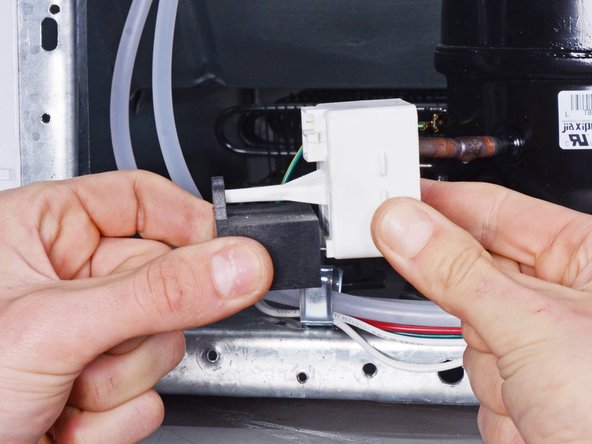
Understanding the Role of a Start Relay in Your Refrigerator Compressor
Share
When it comes to keeping your refrigerator running smoothly, the compressor plays a crucial role in maintaining the cold temperatures we rely on. However, without a small but important part known as the start relay, the compressor might struggle to function properly. In this article, we’ll dive into the essential function of a start relay, how it works, and why it’s critical for the health of your refrigerator.
What Is a Start Relay?
The start relay is a vital component attached to the compressor of your refrigerator. The compressor itself is responsible for circulating refrigerant through the appliance’s cooling system to maintain the cold temperatures inside. However, the compressor requires a boost of power to get started, and that’s where the start relay comes in.
The role of the start relay is to provide the initial jolt of electricity that powers the start winding (a coil inside the compressor). This winding provides additional torque that is necessary to turn the compressor on. Once the compressor starts running, the start relay disconnects the start winding, leaving the motor to run efficiently using the run winding.
How Does the Start Relay Work?
The process of how the start relay helps the compressor function is as follows:
-
Power On: When you first turn on your refrigerator, the start relay activates and sends electricity to the compressor motor, which powers both the start winding and the run winding.
-
Initial Start: The start winding provides extra torque to help the compressor motor get up to speed. This additional force allows the motor to begin operating.
-
Switching Off: Once the compressor reaches its proper running speed, the start relay disconnects the start winding, leaving only the run winding engaged. The compressor continues to run smoothly and efficiently.
By doing this, the start relay ensures that your refrigerator’s compressor works efficiently, preventing unnecessary wear and tear and ensuring consistent cooling inside the fridge.
Why Is the Start Relay Important?
The start relay is more than just a small electrical component. It plays a direct role in the reliability and longevity of your refrigerator. If the start relay fails, the compressor may fail to start or may not run as efficiently, resulting in a few noticeable problems:
-
Refrigerator Is Warm: Without the compressor running properly, the temperature inside your fridge will rise, and food may spoil.
-
Frequent Clicking Sounds: A malfunctioning start relay may cause the compressor to repeatedly try and fail to start, resulting in a clicking noise every few minutes.
-
Overheating Compressor: If the start relay is not functioning correctly, the compressor may overheat, which can cause significant damage to the motor over time.
In short, the start relay helps your refrigerator maintain a cold and consistent temperature while ensuring the compressor operates efficiently.
Signs of a Faulty Start Relay
If your refrigerator is experiencing any of the following symptoms, it might be time to check the start relay:
-
Warm Refrigerator: If the fridge isn’t staying cold and the compressor is not turning on, the start relay could be at fault.
-
Clicking Noise: If you hear a repeated clicking sound coming from the bottom of the fridge (near the compressor), it may indicate that the start relay is malfunctioning.
-
Hot Compressor: A compressor that’s excessively hot to the touch, especially when the fridge isn’t cooling properly, is another sign of a faulty start relay.
Can You Replace the Start Relay Yourself?
If you’re handy with appliances and feel comfortable working with electrical components, you can replace the start relay yourself. Here’s a basic outline of the steps involved:
-
Unplug the Refrigerator: Always disconnect the power before working on any appliance.
-
Locate the Compressor: The start relay is attached to the side or bottom of the compressor, usually inside a panel at the back of the fridge.
-
Remove the Old Relay: Carefully remove the faulty relay and disconnect any wires.
-
Install the New Relay: Attach the new start relay in the same position and reconnect the wires.
-
Test the Fridge: Plug the fridge back in and check to see if the compressor starts properly.
If you’re not comfortable doing the repair yourself, it’s always a good idea to call a professional appliance repair technician.
Why Choose PRS Parts Inc. for Replacement Parts?
If you’ve determined that the start relay is the culprit and need a replacement, PRS Parts Inc. is your trusted source for high-quality appliance parts. Our knowledgeable team can help you find the exact part you need for your refrigerator model. We offer expert assistance and fast service, ensuring that you get the right part to keep your appliance in top shape.
Conclusion
The start relay plays a critical role in ensuring your refrigerator compressor starts smoothly and operates efficiently. Without it, your fridge may not maintain the cold temperatures you depend on. If you suspect an issue with the start relay, it's important to address it promptly to avoid further damage to the compressor or other components. Whether you’re replacing the relay yourself or seeking expert help, make sure to use high-quality parts to ensure your refrigerator’s longevity.
For authentic appliance replacement parts and expert repair assistance, visit PRS Parts Inc. at 540 Lagoon Dr. Our team is here to provide the solutions you need to keep your refrigerator running efficiently.
"Image courtesy of iFixit, from their guide on Whirlpool Refrigerator Start Relay Assembly Replacement."
